Impact of Technical and Stakeholder Issues on Organizational Success
VerifiedAdded on 2023/06/15
|18
|5337
|135
Report
AI Summary
This report critically evaluates the impact of technical and stakeholder issues on organizational success. It reviews literature on change management, project management, and stakeholder analysis, highlighting the importance of stakeholder involvement in strategic projects. The report discusses stakeholder categorization, prioritization, and potential conflicts, emphasizing the need for effective communication and alignment of goals. It also outlines the steps in stakeholder analysis, including identification, prioritization, and management, to ensure project success. The study emphasizes the significance of both internal and external stakeholders and their influence on product quality, productivity, and overall organizational effectiveness.

Running head: IMPACT OF TECHNICAL AND STAKEHOLDER ISSUES 1
Name
Institution
Course
Date
Name
Institution
Course
Date
Paraphrase This Document
Need a fresh take? Get an instant paraphrase of this document with our AI Paraphraser
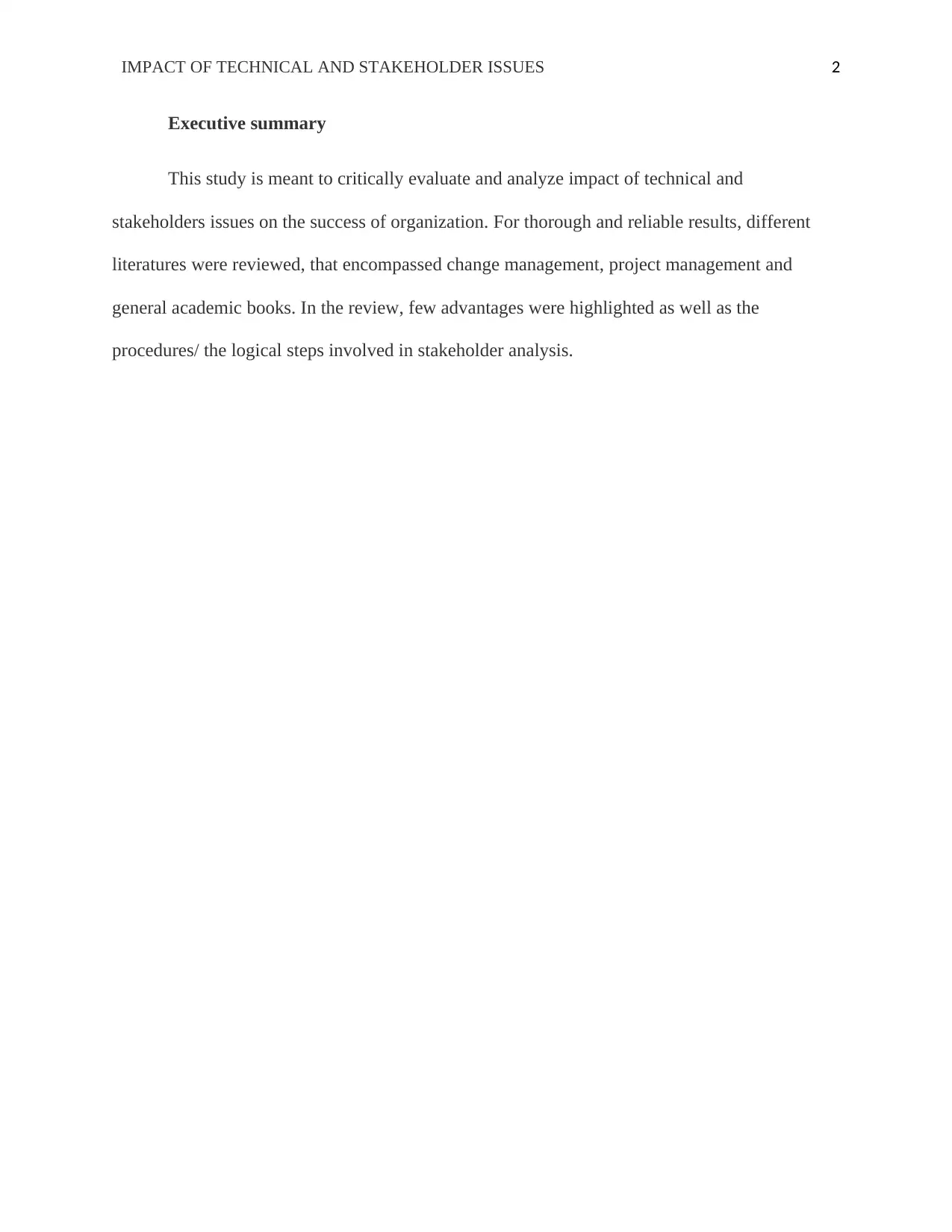
IMPACT OF TECHNICAL AND STAKEHOLDER ISSUES 2
Executive summary
This study is meant to critically evaluate and analyze impact of technical and
stakeholders issues on the success of organization. For thorough and reliable results, different
literatures were reviewed, that encompassed change management, project management and
general academic books. In the review, few advantages were highlighted as well as the
procedures/ the logical steps involved in stakeholder analysis.
Executive summary
This study is meant to critically evaluate and analyze impact of technical and
stakeholders issues on the success of organization. For thorough and reliable results, different
literatures were reviewed, that encompassed change management, project management and
general academic books. In the review, few advantages were highlighted as well as the
procedures/ the logical steps involved in stakeholder analysis.
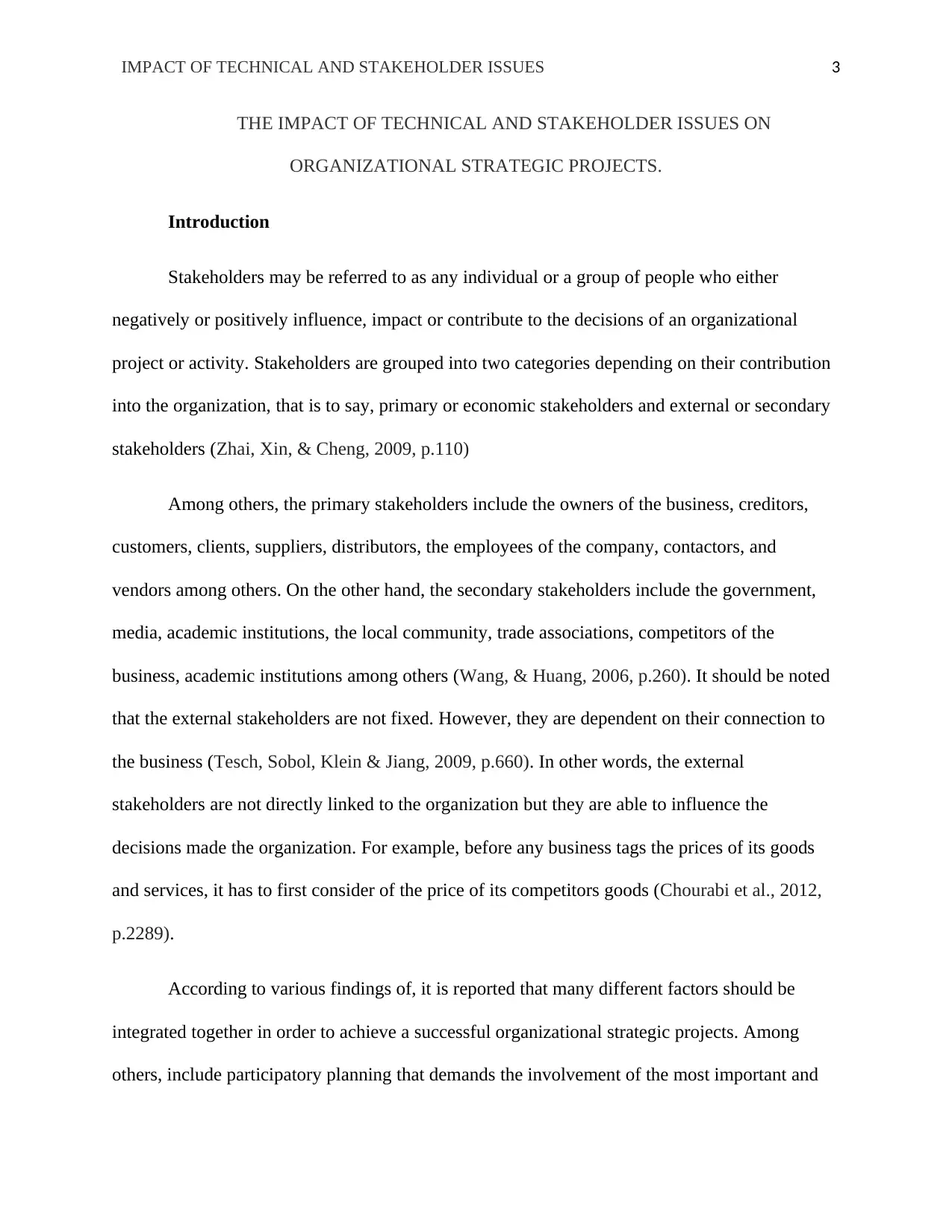
IMPACT OF TECHNICAL AND STAKEHOLDER ISSUES 3
THE IMPACT OF TECHNICAL AND STAKEHOLDER ISSUES ON
ORGANIZATIONAL STRATEGIC PROJECTS.
Introduction
Stakeholders may be referred to as any individual or a group of people who either
negatively or positively influence, impact or contribute to the decisions of an organizational
project or activity. Stakeholders are grouped into two categories depending on their contribution
into the organization, that is to say, primary or economic stakeholders and external or secondary
stakeholders (Zhai, Xin, & Cheng, 2009, p.110)
Among others, the primary stakeholders include the owners of the business, creditors,
customers, clients, suppliers, distributors, the employees of the company, contactors, and
vendors among others. On the other hand, the secondary stakeholders include the government,
media, academic institutions, the local community, trade associations, competitors of the
business, academic institutions among others (Wang, & Huang, 2006, p.260). It should be noted
that the external stakeholders are not fixed. However, they are dependent on their connection to
the business (Tesch, Sobol, Klein & Jiang, 2009, p.660). In other words, the external
stakeholders are not directly linked to the organization but they are able to influence the
decisions made the organization. For example, before any business tags the prices of its goods
and services, it has to first consider of the price of its competitors goods (Chourabi et al., 2012,
p.2289).
According to various findings of, it is reported that many different factors should be
integrated together in order to achieve a successful organizational strategic projects. Among
others, include participatory planning that demands the involvement of the most important and
THE IMPACT OF TECHNICAL AND STAKEHOLDER ISSUES ON
ORGANIZATIONAL STRATEGIC PROJECTS.
Introduction
Stakeholders may be referred to as any individual or a group of people who either
negatively or positively influence, impact or contribute to the decisions of an organizational
project or activity. Stakeholders are grouped into two categories depending on their contribution
into the organization, that is to say, primary or economic stakeholders and external or secondary
stakeholders (Zhai, Xin, & Cheng, 2009, p.110)
Among others, the primary stakeholders include the owners of the business, creditors,
customers, clients, suppliers, distributors, the employees of the company, contactors, and
vendors among others. On the other hand, the secondary stakeholders include the government,
media, academic institutions, the local community, trade associations, competitors of the
business, academic institutions among others (Wang, & Huang, 2006, p.260). It should be noted
that the external stakeholders are not fixed. However, they are dependent on their connection to
the business (Tesch, Sobol, Klein & Jiang, 2009, p.660). In other words, the external
stakeholders are not directly linked to the organization but they are able to influence the
decisions made the organization. For example, before any business tags the prices of its goods
and services, it has to first consider of the price of its competitors goods (Chourabi et al., 2012,
p.2289).
According to various findings of, it is reported that many different factors should be
integrated together in order to achieve a successful organizational strategic projects. Among
others, include participatory planning that demands the involvement of the most important and
You're viewing a preview
Unlock full access by subscribing today!
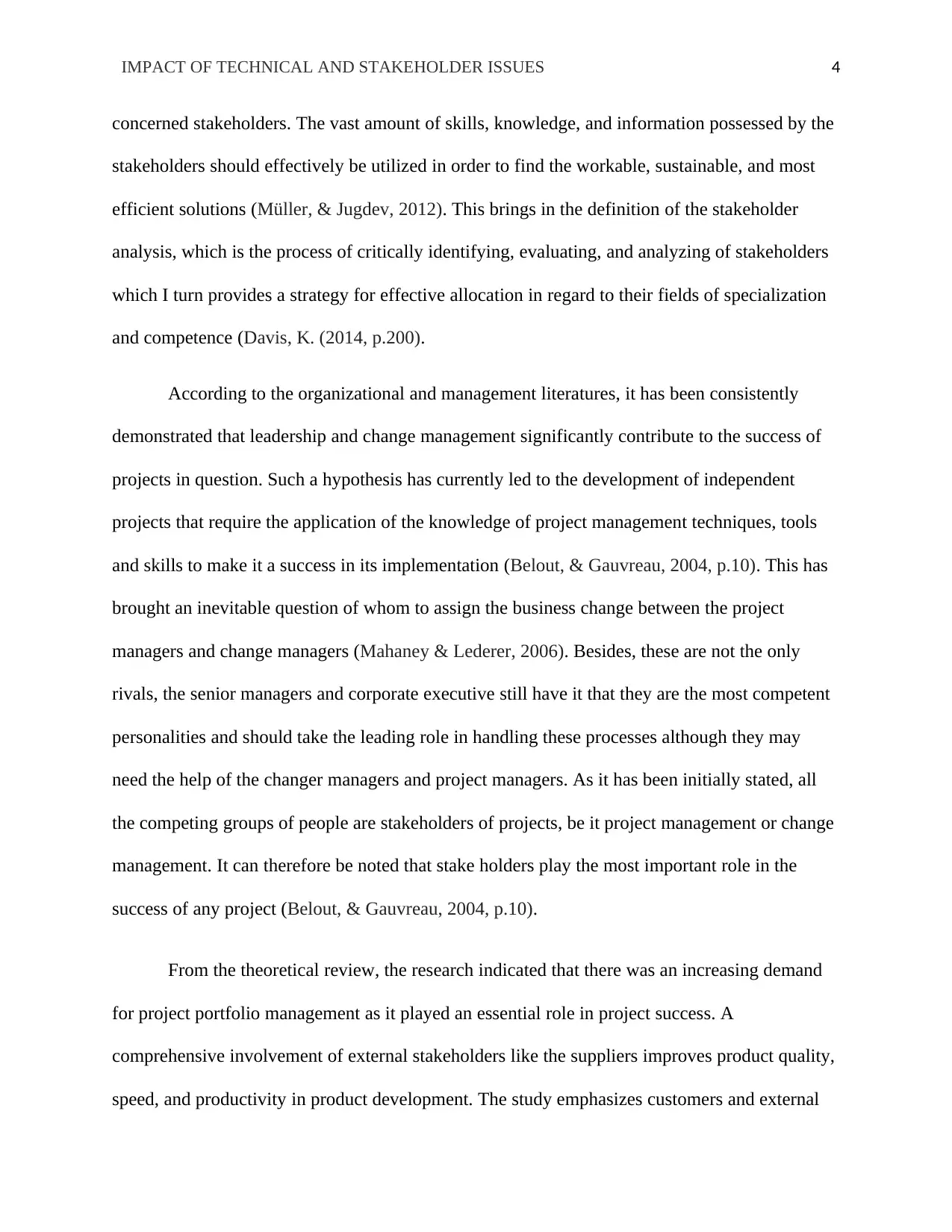
IMPACT OF TECHNICAL AND STAKEHOLDER ISSUES 4
concerned stakeholders. The vast amount of skills, knowledge, and information possessed by the
stakeholders should effectively be utilized in order to find the workable, sustainable, and most
efficient solutions (Müller, & Jugdev, 2012). This brings in the definition of the stakeholder
analysis, which is the process of critically identifying, evaluating, and analyzing of stakeholders
which I turn provides a strategy for effective allocation in regard to their fields of specialization
and competence (Davis, K. (2014, p.200).
According to the organizational and management literatures, it has been consistently
demonstrated that leadership and change management significantly contribute to the success of
projects in question. Such a hypothesis has currently led to the development of independent
projects that require the application of the knowledge of project management techniques, tools
and skills to make it a success in its implementation (Belout, & Gauvreau, 2004, p.10). This has
brought an inevitable question of whom to assign the business change between the project
managers and change managers (Mahaney & Lederer, 2006). Besides, these are not the only
rivals, the senior managers and corporate executive still have it that they are the most competent
personalities and should take the leading role in handling these processes although they may
need the help of the changer managers and project managers. As it has been initially stated, all
the competing groups of people are stakeholders of projects, be it project management or change
management. It can therefore be noted that stake holders play the most important role in the
success of any project (Belout, & Gauvreau, 2004, p.10).
From the theoretical review, the research indicated that there was an increasing demand
for project portfolio management as it played an essential role in project success. A
comprehensive involvement of external stakeholders like the suppliers improves product quality,
speed, and productivity in product development. The study emphasizes customers and external
concerned stakeholders. The vast amount of skills, knowledge, and information possessed by the
stakeholders should effectively be utilized in order to find the workable, sustainable, and most
efficient solutions (Müller, & Jugdev, 2012). This brings in the definition of the stakeholder
analysis, which is the process of critically identifying, evaluating, and analyzing of stakeholders
which I turn provides a strategy for effective allocation in regard to their fields of specialization
and competence (Davis, K. (2014, p.200).
According to the organizational and management literatures, it has been consistently
demonstrated that leadership and change management significantly contribute to the success of
projects in question. Such a hypothesis has currently led to the development of independent
projects that require the application of the knowledge of project management techniques, tools
and skills to make it a success in its implementation (Belout, & Gauvreau, 2004, p.10). This has
brought an inevitable question of whom to assign the business change between the project
managers and change managers (Mahaney & Lederer, 2006). Besides, these are not the only
rivals, the senior managers and corporate executive still have it that they are the most competent
personalities and should take the leading role in handling these processes although they may
need the help of the changer managers and project managers. As it has been initially stated, all
the competing groups of people are stakeholders of projects, be it project management or change
management. It can therefore be noted that stake holders play the most important role in the
success of any project (Belout, & Gauvreau, 2004, p.10).
From the theoretical review, the research indicated that there was an increasing demand
for project portfolio management as it played an essential role in project success. A
comprehensive involvement of external stakeholders like the suppliers improves product quality,
speed, and productivity in product development. The study emphasizes customers and external
Paraphrase This Document
Need a fresh take? Get an instant paraphrase of this document with our AI Paraphraser
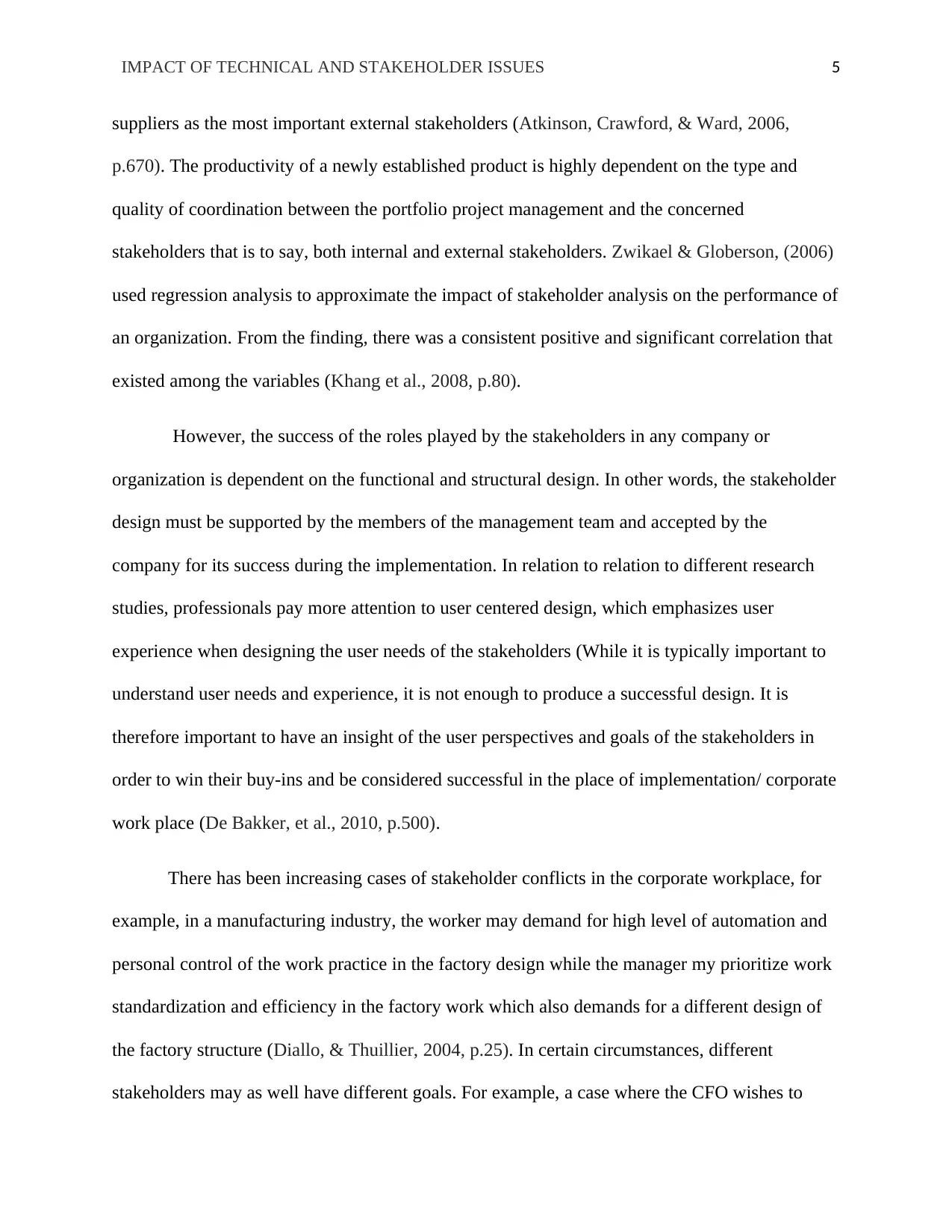
IMPACT OF TECHNICAL AND STAKEHOLDER ISSUES 5
suppliers as the most important external stakeholders (Atkinson, Crawford, & Ward, 2006,
p.670). The productivity of a newly established product is highly dependent on the type and
quality of coordination between the portfolio project management and the concerned
stakeholders that is to say, both internal and external stakeholders. Zwikael & Globerson, (2006)
used regression analysis to approximate the impact of stakeholder analysis on the performance of
an organization. From the finding, there was a consistent positive and significant correlation that
existed among the variables (Khang et al., 2008, p.80).
However, the success of the roles played by the stakeholders in any company or
organization is dependent on the functional and structural design. In other words, the stakeholder
design must be supported by the members of the management team and accepted by the
company for its success during the implementation. In relation to relation to different research
studies, professionals pay more attention to user centered design, which emphasizes user
experience when designing the user needs of the stakeholders (While it is typically important to
understand user needs and experience, it is not enough to produce a successful design. It is
therefore important to have an insight of the user perspectives and goals of the stakeholders in
order to win their buy-ins and be considered successful in the place of implementation/ corporate
work place (De Bakker, et al., 2010, p.500).
There has been increasing cases of stakeholder conflicts in the corporate workplace, for
example, in a manufacturing industry, the worker may demand for high level of automation and
personal control of the work practice in the factory design while the manager my prioritize work
standardization and efficiency in the factory work which also demands for a different design of
the factory structure (Diallo, & Thuillier, 2004, p.25). In certain circumstances, different
stakeholders may as well have different goals. For example, a case where the CFO wishes to
suppliers as the most important external stakeholders (Atkinson, Crawford, & Ward, 2006,
p.670). The productivity of a newly established product is highly dependent on the type and
quality of coordination between the portfolio project management and the concerned
stakeholders that is to say, both internal and external stakeholders. Zwikael & Globerson, (2006)
used regression analysis to approximate the impact of stakeholder analysis on the performance of
an organization. From the finding, there was a consistent positive and significant correlation that
existed among the variables (Khang et al., 2008, p.80).
However, the success of the roles played by the stakeholders in any company or
organization is dependent on the functional and structural design. In other words, the stakeholder
design must be supported by the members of the management team and accepted by the
company for its success during the implementation. In relation to relation to different research
studies, professionals pay more attention to user centered design, which emphasizes user
experience when designing the user needs of the stakeholders (While it is typically important to
understand user needs and experience, it is not enough to produce a successful design. It is
therefore important to have an insight of the user perspectives and goals of the stakeholders in
order to win their buy-ins and be considered successful in the place of implementation/ corporate
work place (De Bakker, et al., 2010, p.500).
There has been increasing cases of stakeholder conflicts in the corporate workplace, for
example, in a manufacturing industry, the worker may demand for high level of automation and
personal control of the work practice in the factory design while the manager my prioritize work
standardization and efficiency in the factory work which also demands for a different design of
the factory structure (Diallo, & Thuillier, 2004, p.25). In certain circumstances, different
stakeholders may as well have different goals. For example, a case where the CFO wishes to
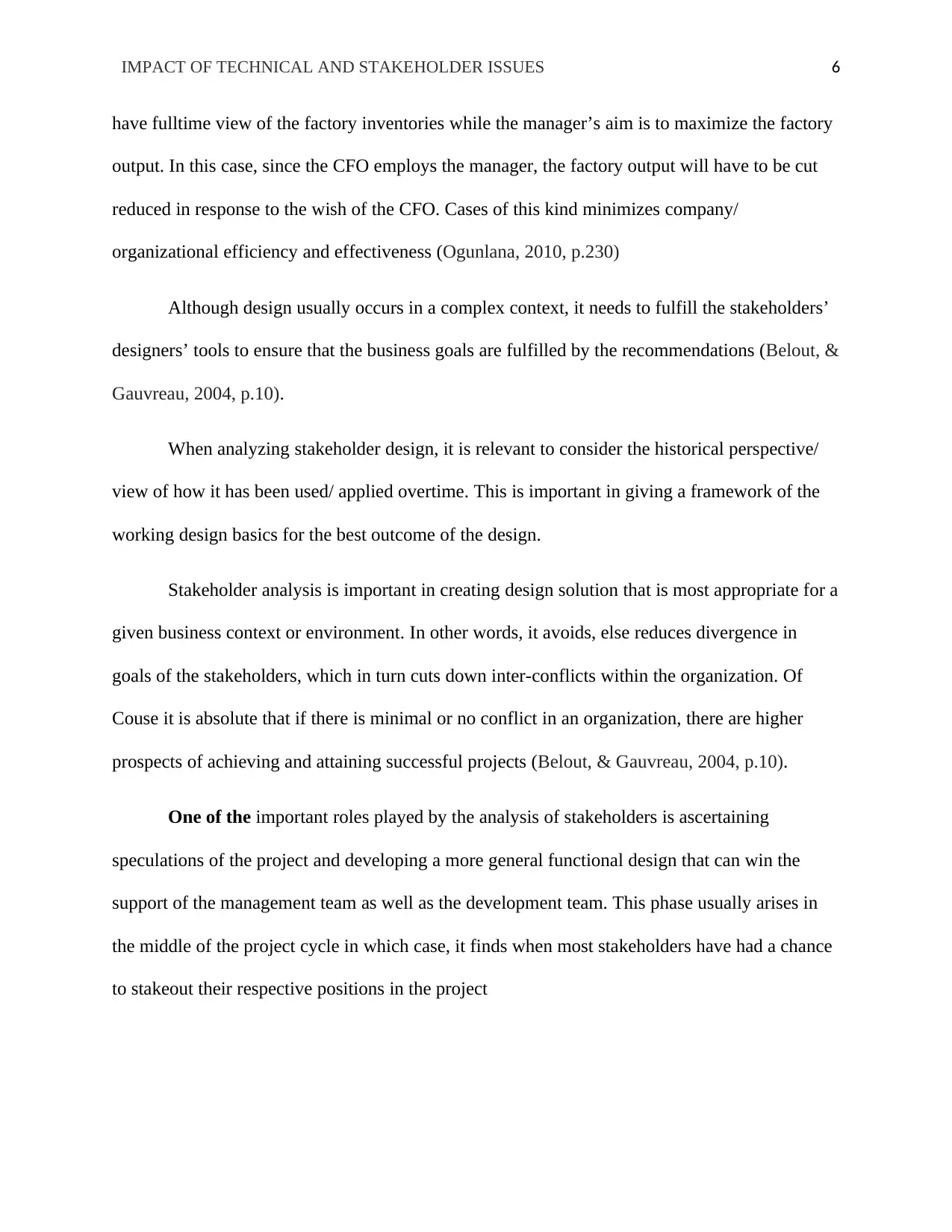
IMPACT OF TECHNICAL AND STAKEHOLDER ISSUES 6
have fulltime view of the factory inventories while the manager’s aim is to maximize the factory
output. In this case, since the CFO employs the manager, the factory output will have to be cut
reduced in response to the wish of the CFO. Cases of this kind minimizes company/
organizational efficiency and effectiveness (Ogunlana, 2010, p.230)
Although design usually occurs in a complex context, it needs to fulfill the stakeholders’
designers’ tools to ensure that the business goals are fulfilled by the recommendations (Belout, &
Gauvreau, 2004, p.10).
When analyzing stakeholder design, it is relevant to consider the historical perspective/
view of how it has been used/ applied overtime. This is important in giving a framework of the
working design basics for the best outcome of the design.
Stakeholder analysis is important in creating design solution that is most appropriate for a
given business context or environment. In other words, it avoids, else reduces divergence in
goals of the stakeholders, which in turn cuts down inter-conflicts within the organization. Of
Couse it is absolute that if there is minimal or no conflict in an organization, there are higher
prospects of achieving and attaining successful projects (Belout, & Gauvreau, 2004, p.10).
One of the important roles played by the analysis of stakeholders is ascertaining
speculations of the project and developing a more general functional design that can win the
support of the management team as well as the development team. This phase usually arises in
the middle of the project cycle in which case, it finds when most stakeholders have had a chance
to stakeout their respective positions in the project
have fulltime view of the factory inventories while the manager’s aim is to maximize the factory
output. In this case, since the CFO employs the manager, the factory output will have to be cut
reduced in response to the wish of the CFO. Cases of this kind minimizes company/
organizational efficiency and effectiveness (Ogunlana, 2010, p.230)
Although design usually occurs in a complex context, it needs to fulfill the stakeholders’
designers’ tools to ensure that the business goals are fulfilled by the recommendations (Belout, &
Gauvreau, 2004, p.10).
When analyzing stakeholder design, it is relevant to consider the historical perspective/
view of how it has been used/ applied overtime. This is important in giving a framework of the
working design basics for the best outcome of the design.
Stakeholder analysis is important in creating design solution that is most appropriate for a
given business context or environment. In other words, it avoids, else reduces divergence in
goals of the stakeholders, which in turn cuts down inter-conflicts within the organization. Of
Couse it is absolute that if there is minimal or no conflict in an organization, there are higher
prospects of achieving and attaining successful projects (Belout, & Gauvreau, 2004, p.10).
One of the important roles played by the analysis of stakeholders is ascertaining
speculations of the project and developing a more general functional design that can win the
support of the management team as well as the development team. This phase usually arises in
the middle of the project cycle in which case, it finds when most stakeholders have had a chance
to stakeout their respective positions in the project
You're viewing a preview
Unlock full access by subscribing today!
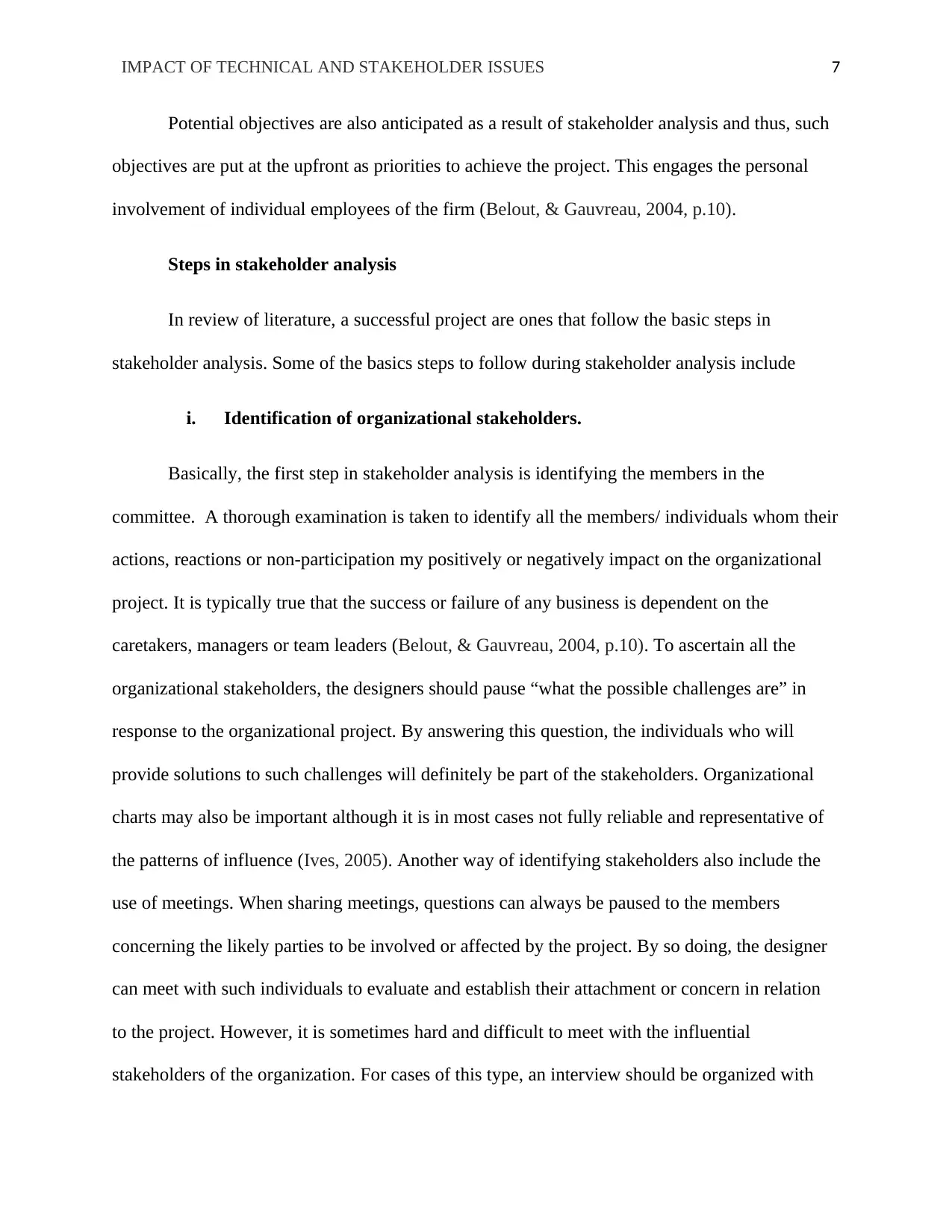
IMPACT OF TECHNICAL AND STAKEHOLDER ISSUES 7
Potential objectives are also anticipated as a result of stakeholder analysis and thus, such
objectives are put at the upfront as priorities to achieve the project. This engages the personal
involvement of individual employees of the firm (Belout, & Gauvreau, 2004, p.10).
Steps in stakeholder analysis
In review of literature, a successful project are ones that follow the basic steps in
stakeholder analysis. Some of the basics steps to follow during stakeholder analysis include
i. Identification of organizational stakeholders.
Basically, the first step in stakeholder analysis is identifying the members in the
committee. A thorough examination is taken to identify all the members/ individuals whom their
actions, reactions or non-participation my positively or negatively impact on the organizational
project. It is typically true that the success or failure of any business is dependent on the
caretakers, managers or team leaders (Belout, & Gauvreau, 2004, p.10). To ascertain all the
organizational stakeholders, the designers should pause “what the possible challenges are” in
response to the organizational project. By answering this question, the individuals who will
provide solutions to such challenges will definitely be part of the stakeholders. Organizational
charts may also be important although it is in most cases not fully reliable and representative of
the patterns of influence (Ives, 2005). Another way of identifying stakeholders also include the
use of meetings. When sharing meetings, questions can always be paused to the members
concerning the likely parties to be involved or affected by the project. By so doing, the designer
can meet with such individuals to evaluate and establish their attachment or concern in relation
to the project. However, it is sometimes hard and difficult to meet with the influential
stakeholders of the organization. For cases of this type, an interview should be organized with
Potential objectives are also anticipated as a result of stakeholder analysis and thus, such
objectives are put at the upfront as priorities to achieve the project. This engages the personal
involvement of individual employees of the firm (Belout, & Gauvreau, 2004, p.10).
Steps in stakeholder analysis
In review of literature, a successful project are ones that follow the basic steps in
stakeholder analysis. Some of the basics steps to follow during stakeholder analysis include
i. Identification of organizational stakeholders.
Basically, the first step in stakeholder analysis is identifying the members in the
committee. A thorough examination is taken to identify all the members/ individuals whom their
actions, reactions or non-participation my positively or negatively impact on the organizational
project. It is typically true that the success or failure of any business is dependent on the
caretakers, managers or team leaders (Belout, & Gauvreau, 2004, p.10). To ascertain all the
organizational stakeholders, the designers should pause “what the possible challenges are” in
response to the organizational project. By answering this question, the individuals who will
provide solutions to such challenges will definitely be part of the stakeholders. Organizational
charts may also be important although it is in most cases not fully reliable and representative of
the patterns of influence (Ives, 2005). Another way of identifying stakeholders also include the
use of meetings. When sharing meetings, questions can always be paused to the members
concerning the likely parties to be involved or affected by the project. By so doing, the designer
can meet with such individuals to evaluate and establish their attachment or concern in relation
to the project. However, it is sometimes hard and difficult to meet with the influential
stakeholders of the organization. For cases of this type, an interview should be organized with
Paraphrase This Document
Need a fresh take? Get an instant paraphrase of this document with our AI Paraphraser
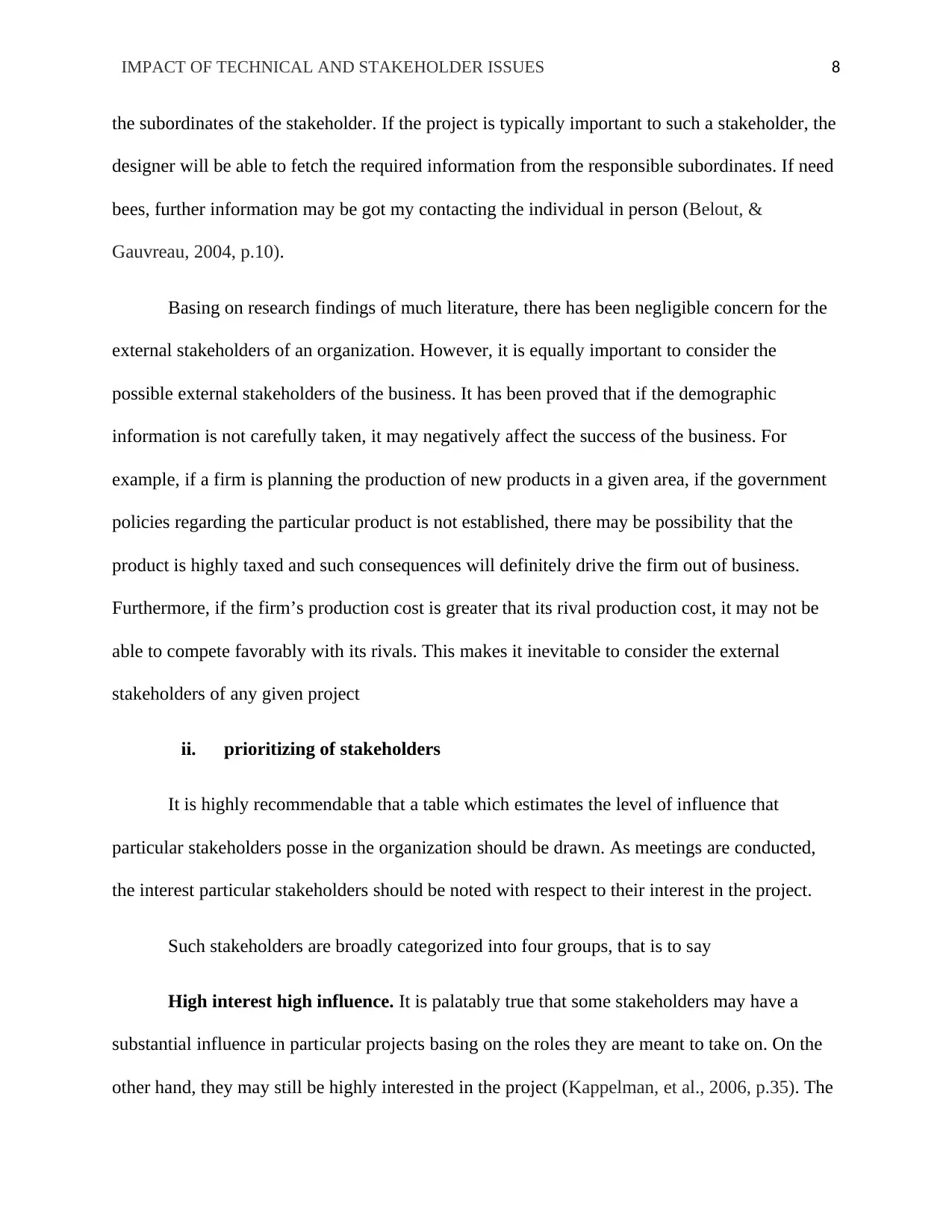
IMPACT OF TECHNICAL AND STAKEHOLDER ISSUES 8
the subordinates of the stakeholder. If the project is typically important to such a stakeholder, the
designer will be able to fetch the required information from the responsible subordinates. If need
bees, further information may be got my contacting the individual in person (Belout, &
Gauvreau, 2004, p.10).
Basing on research findings of much literature, there has been negligible concern for the
external stakeholders of an organization. However, it is equally important to consider the
possible external stakeholders of the business. It has been proved that if the demographic
information is not carefully taken, it may negatively affect the success of the business. For
example, if a firm is planning the production of new products in a given area, if the government
policies regarding the particular product is not established, there may be possibility that the
product is highly taxed and such consequences will definitely drive the firm out of business.
Furthermore, if the firm’s production cost is greater that its rival production cost, it may not be
able to compete favorably with its rivals. This makes it inevitable to consider the external
stakeholders of any given project
ii. prioritizing of stakeholders
It is highly recommendable that a table which estimates the level of influence that
particular stakeholders posse in the organization should be drawn. As meetings are conducted,
the interest particular stakeholders should be noted with respect to their interest in the project.
Such stakeholders are broadly categorized into four groups, that is to say
High interest high influence. It is palatably true that some stakeholders may have a
substantial influence in particular projects basing on the roles they are meant to take on. On the
other hand, they may still be highly interested in the project (Kappelman, et al., 2006, p.35). The
the subordinates of the stakeholder. If the project is typically important to such a stakeholder, the
designer will be able to fetch the required information from the responsible subordinates. If need
bees, further information may be got my contacting the individual in person (Belout, &
Gauvreau, 2004, p.10).
Basing on research findings of much literature, there has been negligible concern for the
external stakeholders of an organization. However, it is equally important to consider the
possible external stakeholders of the business. It has been proved that if the demographic
information is not carefully taken, it may negatively affect the success of the business. For
example, if a firm is planning the production of new products in a given area, if the government
policies regarding the particular product is not established, there may be possibility that the
product is highly taxed and such consequences will definitely drive the firm out of business.
Furthermore, if the firm’s production cost is greater that its rival production cost, it may not be
able to compete favorably with its rivals. This makes it inevitable to consider the external
stakeholders of any given project
ii. prioritizing of stakeholders
It is highly recommendable that a table which estimates the level of influence that
particular stakeholders posse in the organization should be drawn. As meetings are conducted,
the interest particular stakeholders should be noted with respect to their interest in the project.
Such stakeholders are broadly categorized into four groups, that is to say
High interest high influence. It is palatably true that some stakeholders may have a
substantial influence in particular projects basing on the roles they are meant to take on. On the
other hand, they may still be highly interested in the project (Kappelman, et al., 2006, p.35). The
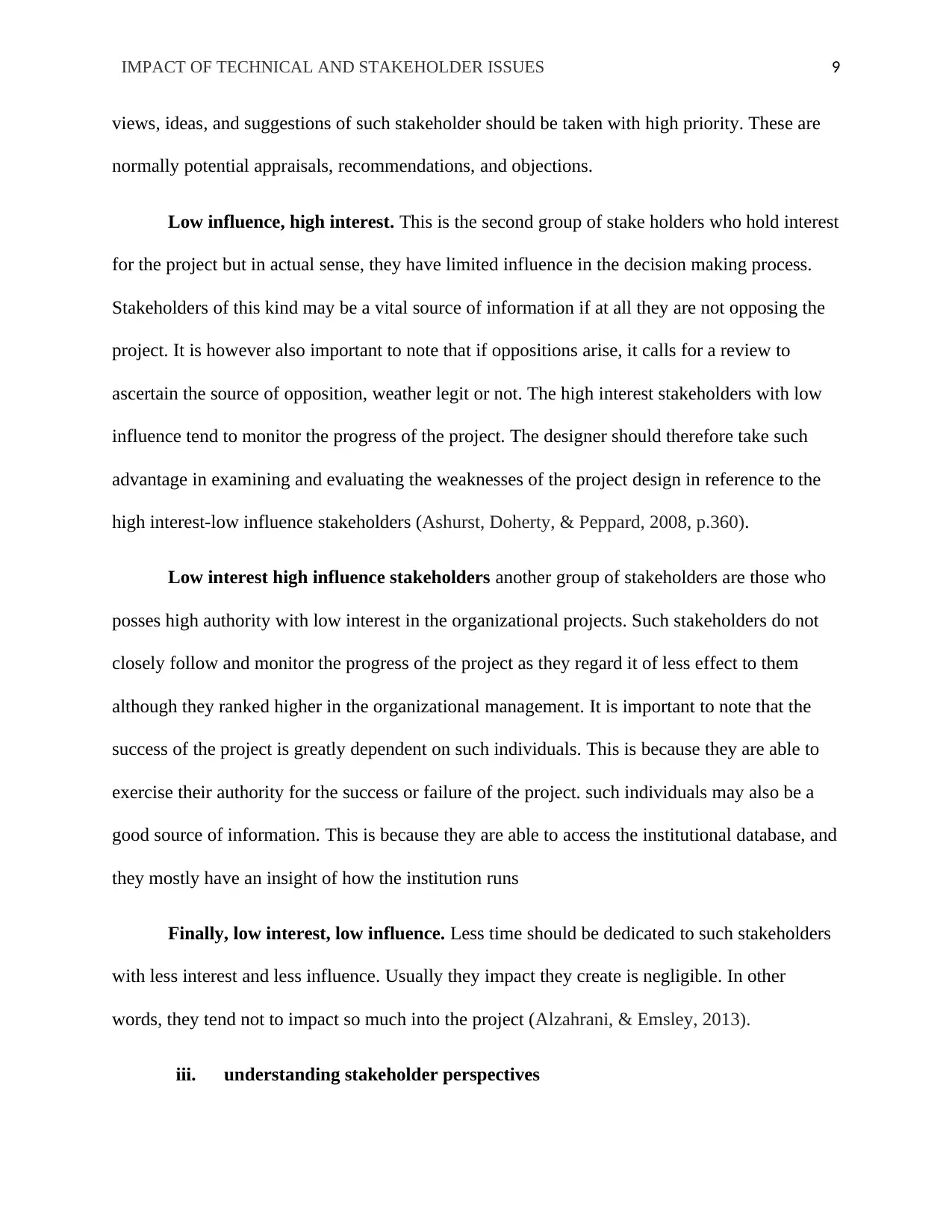
IMPACT OF TECHNICAL AND STAKEHOLDER ISSUES 9
views, ideas, and suggestions of such stakeholder should be taken with high priority. These are
normally potential appraisals, recommendations, and objections.
Low influence, high interest. This is the second group of stake holders who hold interest
for the project but in actual sense, they have limited influence in the decision making process.
Stakeholders of this kind may be a vital source of information if at all they are not opposing the
project. It is however also important to note that if oppositions arise, it calls for a review to
ascertain the source of opposition, weather legit or not. The high interest stakeholders with low
influence tend to monitor the progress of the project. The designer should therefore take such
advantage in examining and evaluating the weaknesses of the project design in reference to the
high interest-low influence stakeholders (Ashurst, Doherty, & Peppard, 2008, p.360).
Low interest high influence stakeholders another group of stakeholders are those who
posses high authority with low interest in the organizational projects. Such stakeholders do not
closely follow and monitor the progress of the project as they regard it of less effect to them
although they ranked higher in the organizational management. It is important to note that the
success of the project is greatly dependent on such individuals. This is because they are able to
exercise their authority for the success or failure of the project. such individuals may also be a
good source of information. This is because they are able to access the institutional database, and
they mostly have an insight of how the institution runs
Finally, low interest, low influence. Less time should be dedicated to such stakeholders
with less interest and less influence. Usually they impact they create is negligible. In other
words, they tend not to impact so much into the project (Alzahrani, & Emsley, 2013).
iii. understanding stakeholder perspectives
views, ideas, and suggestions of such stakeholder should be taken with high priority. These are
normally potential appraisals, recommendations, and objections.
Low influence, high interest. This is the second group of stake holders who hold interest
for the project but in actual sense, they have limited influence in the decision making process.
Stakeholders of this kind may be a vital source of information if at all they are not opposing the
project. It is however also important to note that if oppositions arise, it calls for a review to
ascertain the source of opposition, weather legit or not. The high interest stakeholders with low
influence tend to monitor the progress of the project. The designer should therefore take such
advantage in examining and evaluating the weaknesses of the project design in reference to the
high interest-low influence stakeholders (Ashurst, Doherty, & Peppard, 2008, p.360).
Low interest high influence stakeholders another group of stakeholders are those who
posses high authority with low interest in the organizational projects. Such stakeholders do not
closely follow and monitor the progress of the project as they regard it of less effect to them
although they ranked higher in the organizational management. It is important to note that the
success of the project is greatly dependent on such individuals. This is because they are able to
exercise their authority for the success or failure of the project. such individuals may also be a
good source of information. This is because they are able to access the institutional database, and
they mostly have an insight of how the institution runs
Finally, low interest, low influence. Less time should be dedicated to such stakeholders
with less interest and less influence. Usually they impact they create is negligible. In other
words, they tend not to impact so much into the project (Alzahrani, & Emsley, 2013).
iii. understanding stakeholder perspectives
You're viewing a preview
Unlock full access by subscribing today!
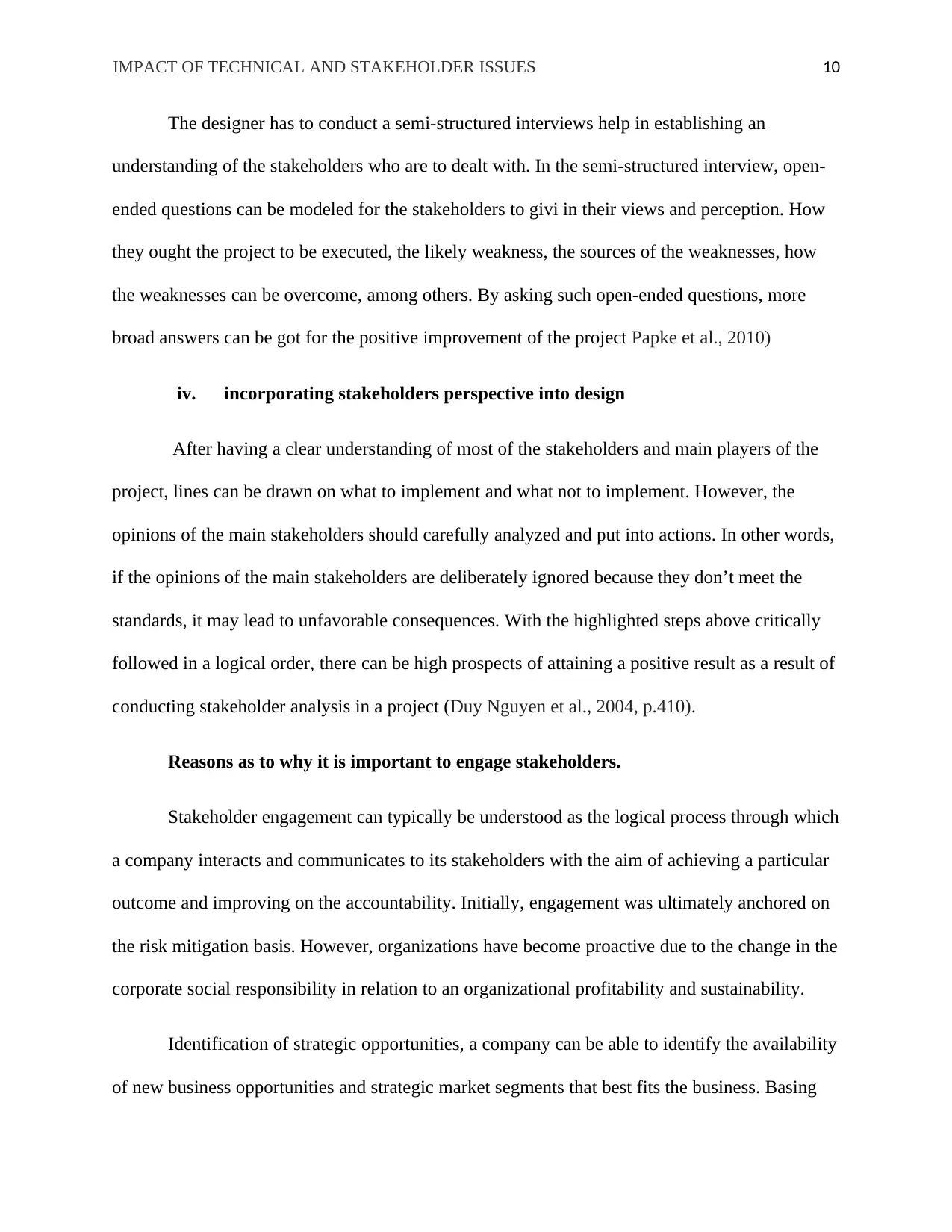
IMPACT OF TECHNICAL AND STAKEHOLDER ISSUES 10
The designer has to conduct a semi-structured interviews help in establishing an
understanding of the stakeholders who are to dealt with. In the semi-structured interview, open-
ended questions can be modeled for the stakeholders to givi in their views and perception. How
they ought the project to be executed, the likely weakness, the sources of the weaknesses, how
the weaknesses can be overcome, among others. By asking such open-ended questions, more
broad answers can be got for the positive improvement of the project Papke et al., 2010)
iv. incorporating stakeholders perspective into design
After having a clear understanding of most of the stakeholders and main players of the
project, lines can be drawn on what to implement and what not to implement. However, the
opinions of the main stakeholders should carefully analyzed and put into actions. In other words,
if the opinions of the main stakeholders are deliberately ignored because they don’t meet the
standards, it may lead to unfavorable consequences. With the highlighted steps above critically
followed in a logical order, there can be high prospects of attaining a positive result as a result of
conducting stakeholder analysis in a project (Duy Nguyen et al., 2004, p.410).
Reasons as to why it is important to engage stakeholders.
Stakeholder engagement can typically be understood as the logical process through which
a company interacts and communicates to its stakeholders with the aim of achieving a particular
outcome and improving on the accountability. Initially, engagement was ultimately anchored on
the risk mitigation basis. However, organizations have become proactive due to the change in the
corporate social responsibility in relation to an organizational profitability and sustainability.
Identification of strategic opportunities, a company can be able to identify the availability
of new business opportunities and strategic market segments that best fits the business. Basing
The designer has to conduct a semi-structured interviews help in establishing an
understanding of the stakeholders who are to dealt with. In the semi-structured interview, open-
ended questions can be modeled for the stakeholders to givi in their views and perception. How
they ought the project to be executed, the likely weakness, the sources of the weaknesses, how
the weaknesses can be overcome, among others. By asking such open-ended questions, more
broad answers can be got for the positive improvement of the project Papke et al., 2010)
iv. incorporating stakeholders perspective into design
After having a clear understanding of most of the stakeholders and main players of the
project, lines can be drawn on what to implement and what not to implement. However, the
opinions of the main stakeholders should carefully analyzed and put into actions. In other words,
if the opinions of the main stakeholders are deliberately ignored because they don’t meet the
standards, it may lead to unfavorable consequences. With the highlighted steps above critically
followed in a logical order, there can be high prospects of attaining a positive result as a result of
conducting stakeholder analysis in a project (Duy Nguyen et al., 2004, p.410).
Reasons as to why it is important to engage stakeholders.
Stakeholder engagement can typically be understood as the logical process through which
a company interacts and communicates to its stakeholders with the aim of achieving a particular
outcome and improving on the accountability. Initially, engagement was ultimately anchored on
the risk mitigation basis. However, organizations have become proactive due to the change in the
corporate social responsibility in relation to an organizational profitability and sustainability.
Identification of strategic opportunities, a company can be able to identify the availability
of new business opportunities and strategic market segments that best fits the business. Basing
Paraphrase This Document
Need a fresh take? Get an instant paraphrase of this document with our AI Paraphraser
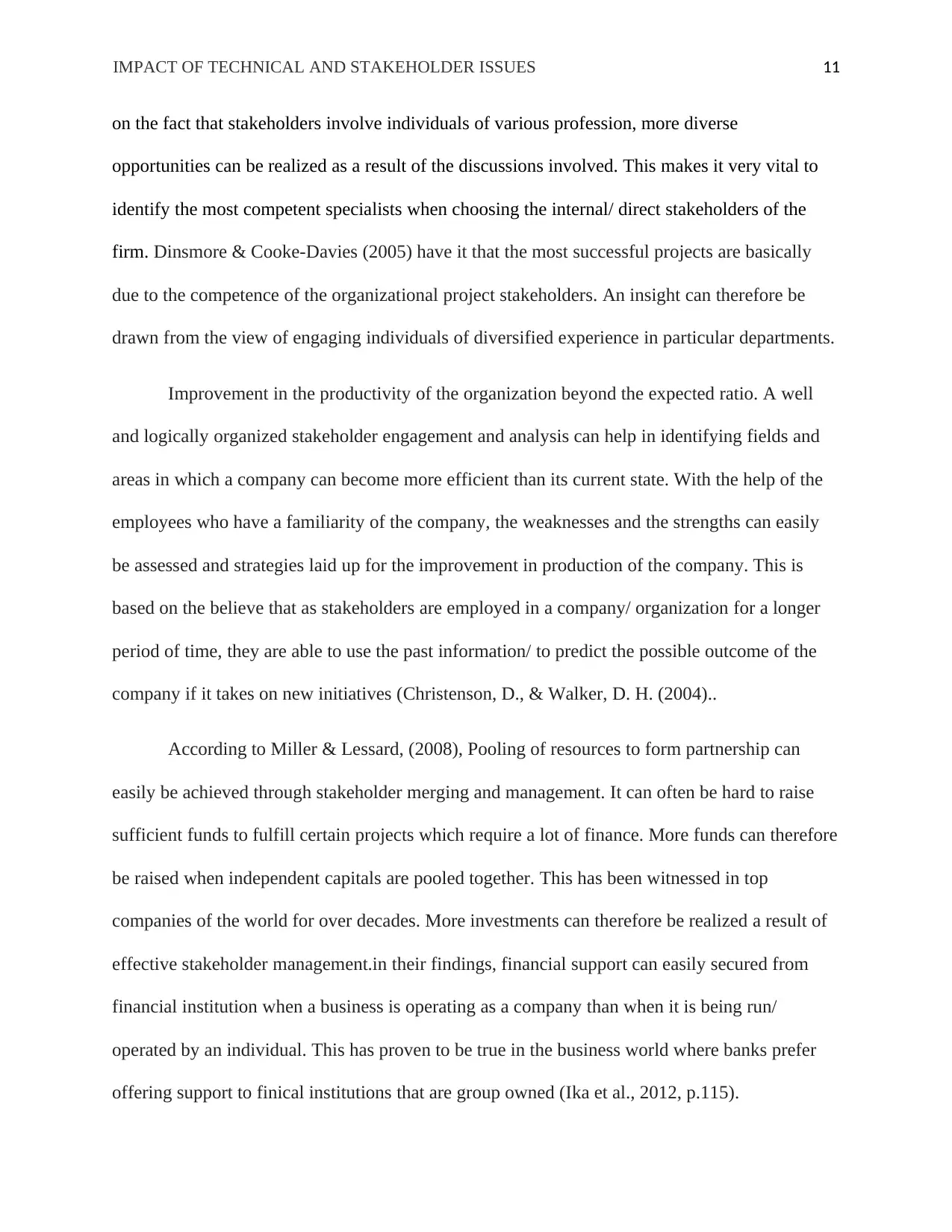
IMPACT OF TECHNICAL AND STAKEHOLDER ISSUES 11
on the fact that stakeholders involve individuals of various profession, more diverse
opportunities can be realized as a result of the discussions involved. This makes it very vital to
identify the most competent specialists when choosing the internal/ direct stakeholders of the
firm. Dinsmore & Cooke-Davies (2005) have it that the most successful projects are basically
due to the competence of the organizational project stakeholders. An insight can therefore be
drawn from the view of engaging individuals of diversified experience in particular departments.
Improvement in the productivity of the organization beyond the expected ratio. A well
and logically organized stakeholder engagement and analysis can help in identifying fields and
areas in which a company can become more efficient than its current state. With the help of the
employees who have a familiarity of the company, the weaknesses and the strengths can easily
be assessed and strategies laid up for the improvement in production of the company. This is
based on the believe that as stakeholders are employed in a company/ organization for a longer
period of time, they are able to use the past information/ to predict the possible outcome of the
company if it takes on new initiatives (Christenson, D., & Walker, D. H. (2004)..
According to Miller & Lessard, (2008), Pooling of resources to form partnership can
easily be achieved through stakeholder merging and management. It can often be hard to raise
sufficient funds to fulfill certain projects which require a lot of finance. More funds can therefore
be raised when independent capitals are pooled together. This has been witnessed in top
companies of the world for over decades. More investments can therefore be realized a result of
effective stakeholder management.in their findings, financial support can easily secured from
financial institution when a business is operating as a company than when it is being run/
operated by an individual. This has proven to be true in the business world where banks prefer
offering support to finical institutions that are group owned (Ika et al., 2012, p.115).
on the fact that stakeholders involve individuals of various profession, more diverse
opportunities can be realized as a result of the discussions involved. This makes it very vital to
identify the most competent specialists when choosing the internal/ direct stakeholders of the
firm. Dinsmore & Cooke-Davies (2005) have it that the most successful projects are basically
due to the competence of the organizational project stakeholders. An insight can therefore be
drawn from the view of engaging individuals of diversified experience in particular departments.
Improvement in the productivity of the organization beyond the expected ratio. A well
and logically organized stakeholder engagement and analysis can help in identifying fields and
areas in which a company can become more efficient than its current state. With the help of the
employees who have a familiarity of the company, the weaknesses and the strengths can easily
be assessed and strategies laid up for the improvement in production of the company. This is
based on the believe that as stakeholders are employed in a company/ organization for a longer
period of time, they are able to use the past information/ to predict the possible outcome of the
company if it takes on new initiatives (Christenson, D., & Walker, D. H. (2004)..
According to Miller & Lessard, (2008), Pooling of resources to form partnership can
easily be achieved through stakeholder merging and management. It can often be hard to raise
sufficient funds to fulfill certain projects which require a lot of finance. More funds can therefore
be raised when independent capitals are pooled together. This has been witnessed in top
companies of the world for over decades. More investments can therefore be realized a result of
effective stakeholder management.in their findings, financial support can easily secured from
financial institution when a business is operating as a company than when it is being run/
operated by an individual. This has proven to be true in the business world where banks prefer
offering support to finical institutions that are group owned (Ika et al., 2012, p.115).
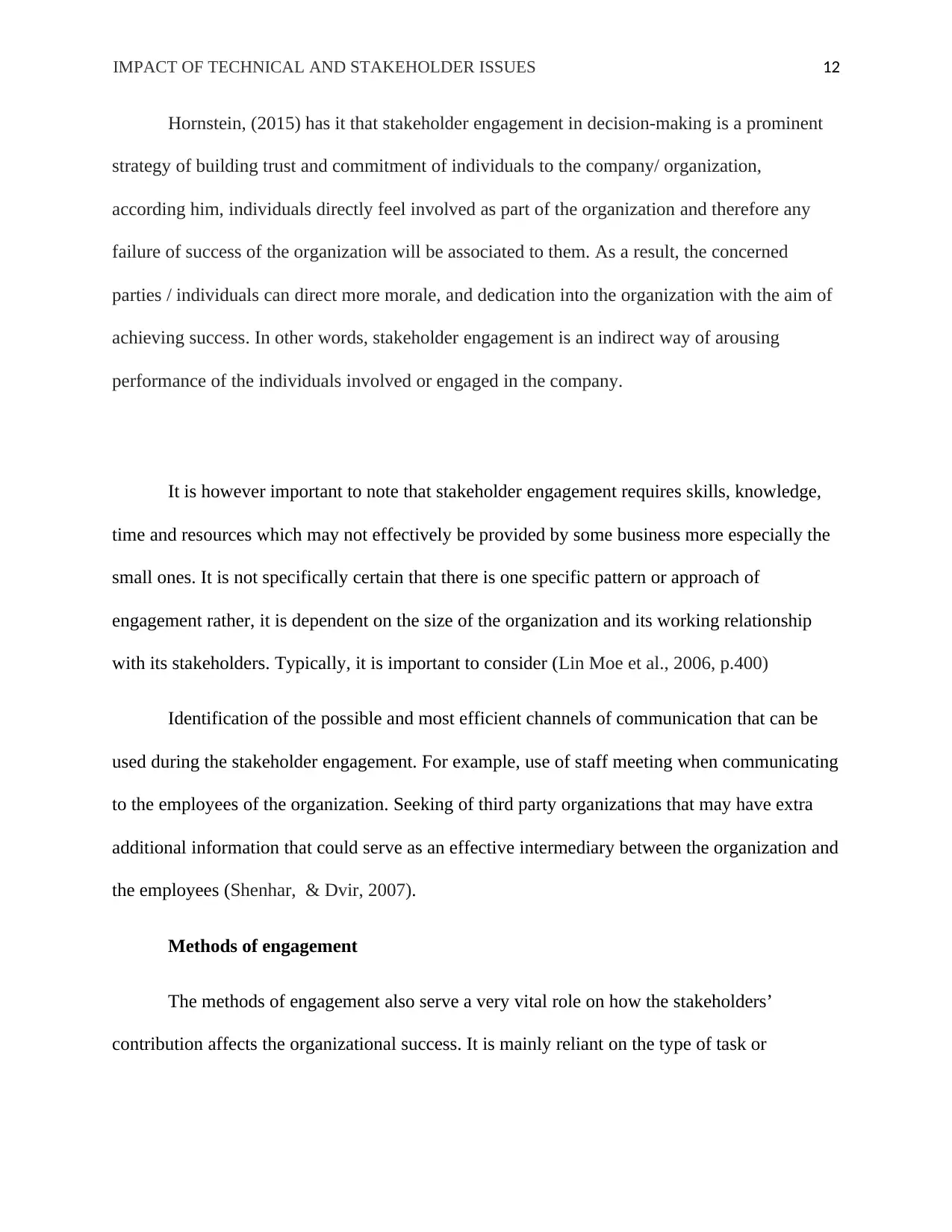
IMPACT OF TECHNICAL AND STAKEHOLDER ISSUES 12
Hornstein, (2015) has it that stakeholder engagement in decision-making is a prominent
strategy of building trust and commitment of individuals to the company/ organization,
according him, individuals directly feel involved as part of the organization and therefore any
failure of success of the organization will be associated to them. As a result, the concerned
parties / individuals can direct more morale, and dedication into the organization with the aim of
achieving success. In other words, stakeholder engagement is an indirect way of arousing
performance of the individuals involved or engaged in the company.
It is however important to note that stakeholder engagement requires skills, knowledge,
time and resources which may not effectively be provided by some business more especially the
small ones. It is not specifically certain that there is one specific pattern or approach of
engagement rather, it is dependent on the size of the organization and its working relationship
with its stakeholders. Typically, it is important to consider (Lin Moe et al., 2006, p.400)
Identification of the possible and most efficient channels of communication that can be
used during the stakeholder engagement. For example, use of staff meeting when communicating
to the employees of the organization. Seeking of third party organizations that may have extra
additional information that could serve as an effective intermediary between the organization and
the employees (Shenhar, & Dvir, 2007).
Methods of engagement
The methods of engagement also serve a very vital role on how the stakeholders’
contribution affects the organizational success. It is mainly reliant on the type of task or
Hornstein, (2015) has it that stakeholder engagement in decision-making is a prominent
strategy of building trust and commitment of individuals to the company/ organization,
according him, individuals directly feel involved as part of the organization and therefore any
failure of success of the organization will be associated to them. As a result, the concerned
parties / individuals can direct more morale, and dedication into the organization with the aim of
achieving success. In other words, stakeholder engagement is an indirect way of arousing
performance of the individuals involved or engaged in the company.
It is however important to note that stakeholder engagement requires skills, knowledge,
time and resources which may not effectively be provided by some business more especially the
small ones. It is not specifically certain that there is one specific pattern or approach of
engagement rather, it is dependent on the size of the organization and its working relationship
with its stakeholders. Typically, it is important to consider (Lin Moe et al., 2006, p.400)
Identification of the possible and most efficient channels of communication that can be
used during the stakeholder engagement. For example, use of staff meeting when communicating
to the employees of the organization. Seeking of third party organizations that may have extra
additional information that could serve as an effective intermediary between the organization and
the employees (Shenhar, & Dvir, 2007).
Methods of engagement
The methods of engagement also serve a very vital role on how the stakeholders’
contribution affects the organizational success. It is mainly reliant on the type of task or
You're viewing a preview
Unlock full access by subscribing today!
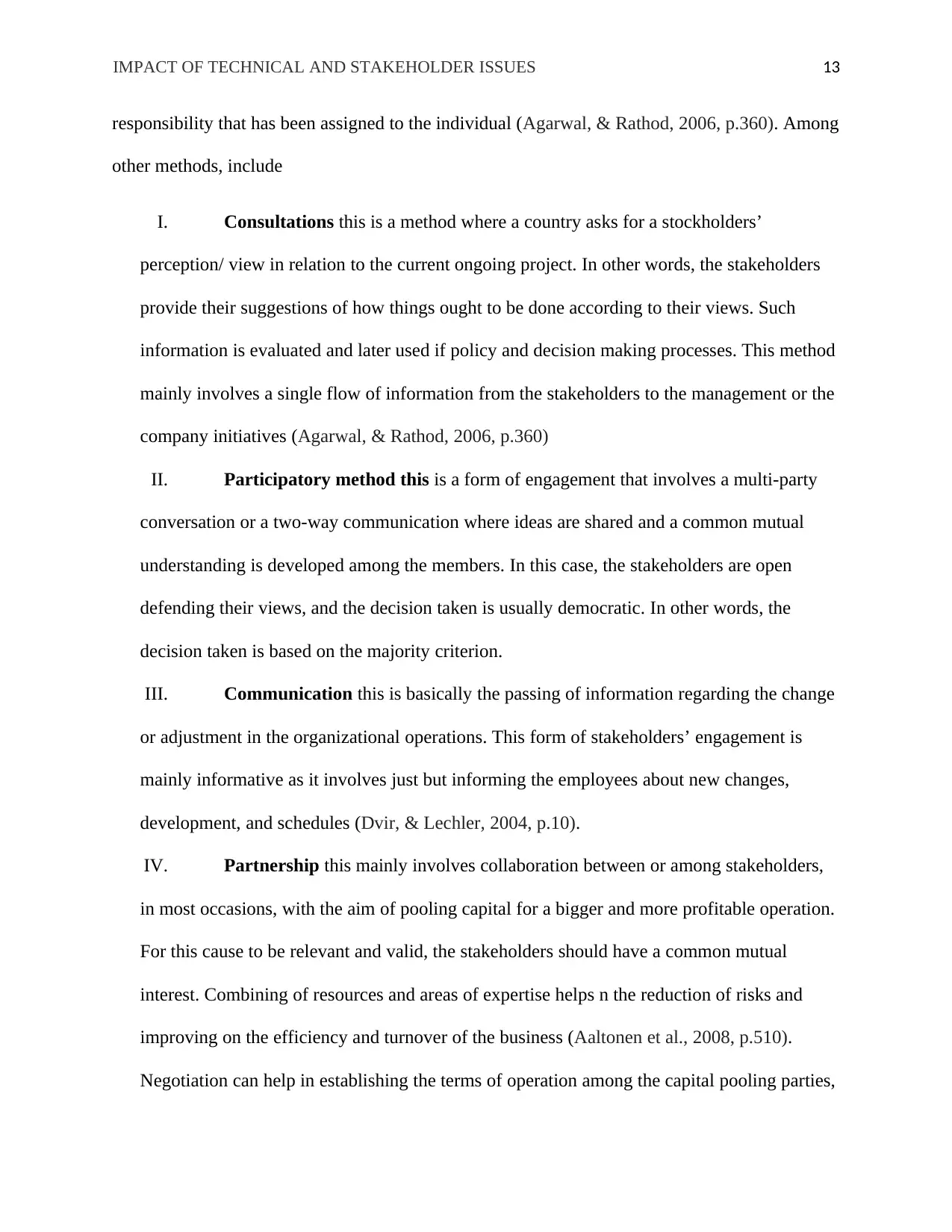
IMPACT OF TECHNICAL AND STAKEHOLDER ISSUES 13
responsibility that has been assigned to the individual (Agarwal, & Rathod, 2006, p.360). Among
other methods, include
I. Consultations this is a method where a country asks for a stockholders’
perception/ view in relation to the current ongoing project. In other words, the stakeholders
provide their suggestions of how things ought to be done according to their views. Such
information is evaluated and later used if policy and decision making processes. This method
mainly involves a single flow of information from the stakeholders to the management or the
company initiatives (Agarwal, & Rathod, 2006, p.360)
II. Participatory method this is a form of engagement that involves a multi-party
conversation or a two-way communication where ideas are shared and a common mutual
understanding is developed among the members. In this case, the stakeholders are open
defending their views, and the decision taken is usually democratic. In other words, the
decision taken is based on the majority criterion.
III. Communication this is basically the passing of information regarding the change
or adjustment in the organizational operations. This form of stakeholders’ engagement is
mainly informative as it involves just but informing the employees about new changes,
development, and schedules (Dvir, & Lechler, 2004, p.10).
IV. Partnership this mainly involves collaboration between or among stakeholders,
in most occasions, with the aim of pooling capital for a bigger and more profitable operation.
For this cause to be relevant and valid, the stakeholders should have a common mutual
interest. Combining of resources and areas of expertise helps n the reduction of risks and
improving on the efficiency and turnover of the business (Aaltonen et al., 2008, p.510).
Negotiation can help in establishing the terms of operation among the capital pooling parties,
responsibility that has been assigned to the individual (Agarwal, & Rathod, 2006, p.360). Among
other methods, include
I. Consultations this is a method where a country asks for a stockholders’
perception/ view in relation to the current ongoing project. In other words, the stakeholders
provide their suggestions of how things ought to be done according to their views. Such
information is evaluated and later used if policy and decision making processes. This method
mainly involves a single flow of information from the stakeholders to the management or the
company initiatives (Agarwal, & Rathod, 2006, p.360)
II. Participatory method this is a form of engagement that involves a multi-party
conversation or a two-way communication where ideas are shared and a common mutual
understanding is developed among the members. In this case, the stakeholders are open
defending their views, and the decision taken is usually democratic. In other words, the
decision taken is based on the majority criterion.
III. Communication this is basically the passing of information regarding the change
or adjustment in the organizational operations. This form of stakeholders’ engagement is
mainly informative as it involves just but informing the employees about new changes,
development, and schedules (Dvir, & Lechler, 2004, p.10).
IV. Partnership this mainly involves collaboration between or among stakeholders,
in most occasions, with the aim of pooling capital for a bigger and more profitable operation.
For this cause to be relevant and valid, the stakeholders should have a common mutual
interest. Combining of resources and areas of expertise helps n the reduction of risks and
improving on the efficiency and turnover of the business (Aaltonen et al., 2008, p.510).
Negotiation can help in establishing the terms of operation among the capital pooling parties,
Paraphrase This Document
Need a fresh take? Get an instant paraphrase of this document with our AI Paraphraser
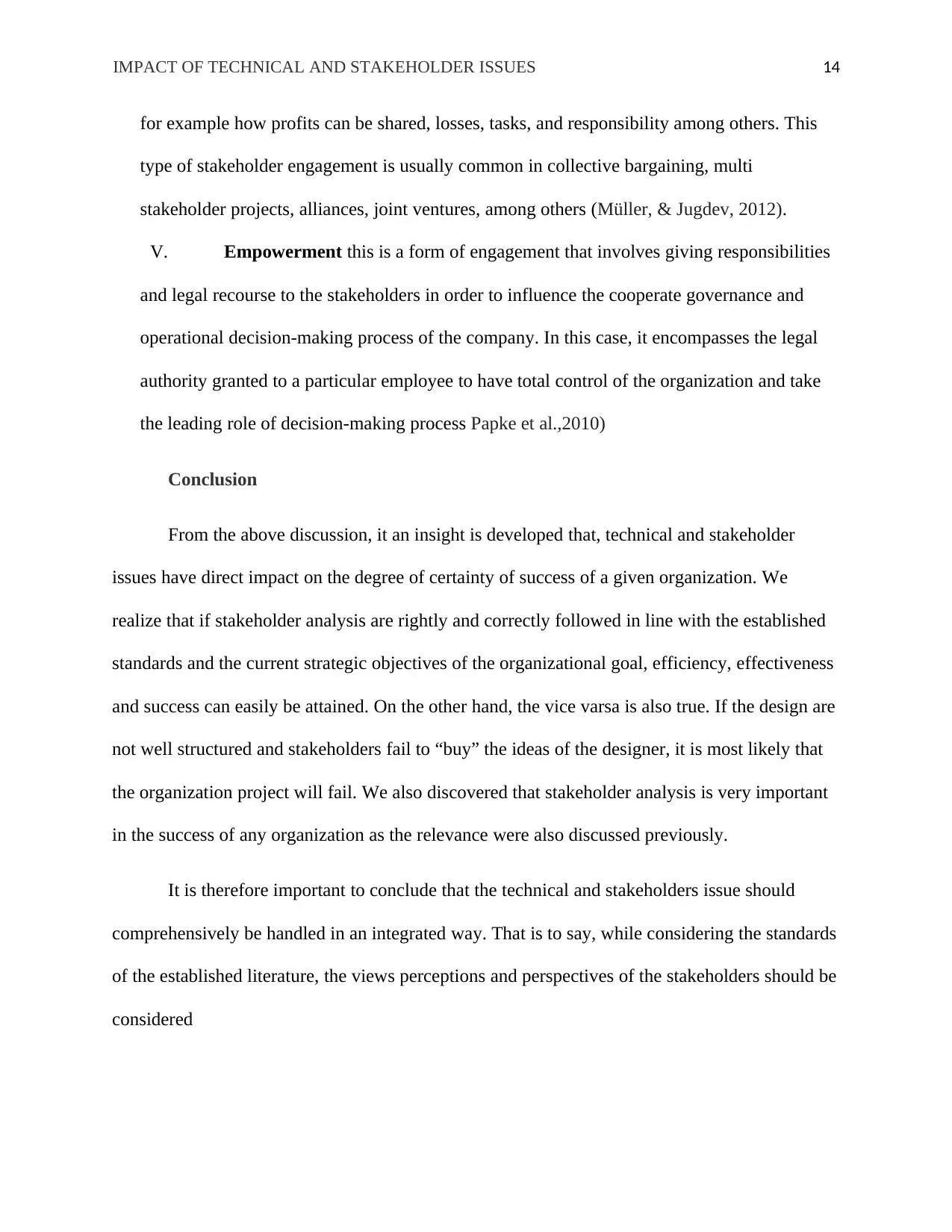
IMPACT OF TECHNICAL AND STAKEHOLDER ISSUES 14
for example how profits can be shared, losses, tasks, and responsibility among others. This
type of stakeholder engagement is usually common in collective bargaining, multi
stakeholder projects, alliances, joint ventures, among others (Müller, & Jugdev, 2012).
V. Empowerment this is a form of engagement that involves giving responsibilities
and legal recourse to the stakeholders in order to influence the cooperate governance and
operational decision-making process of the company. In this case, it encompasses the legal
authority granted to a particular employee to have total control of the organization and take
the leading role of decision-making process Papke et al.,2010)
Conclusion
From the above discussion, it an insight is developed that, technical and stakeholder
issues have direct impact on the degree of certainty of success of a given organization. We
realize that if stakeholder analysis are rightly and correctly followed in line with the established
standards and the current strategic objectives of the organizational goal, efficiency, effectiveness
and success can easily be attained. On the other hand, the vice varsa is also true. If the design are
not well structured and stakeholders fail to “buy” the ideas of the designer, it is most likely that
the organization project will fail. We also discovered that stakeholder analysis is very important
in the success of any organization as the relevance were also discussed previously.
It is therefore important to conclude that the technical and stakeholders issue should
comprehensively be handled in an integrated way. That is to say, while considering the standards
of the established literature, the views perceptions and perspectives of the stakeholders should be
considered
for example how profits can be shared, losses, tasks, and responsibility among others. This
type of stakeholder engagement is usually common in collective bargaining, multi
stakeholder projects, alliances, joint ventures, among others (Müller, & Jugdev, 2012).
V. Empowerment this is a form of engagement that involves giving responsibilities
and legal recourse to the stakeholders in order to influence the cooperate governance and
operational decision-making process of the company. In this case, it encompasses the legal
authority granted to a particular employee to have total control of the organization and take
the leading role of decision-making process Papke et al.,2010)
Conclusion
From the above discussion, it an insight is developed that, technical and stakeholder
issues have direct impact on the degree of certainty of success of a given organization. We
realize that if stakeholder analysis are rightly and correctly followed in line with the established
standards and the current strategic objectives of the organizational goal, efficiency, effectiveness
and success can easily be attained. On the other hand, the vice varsa is also true. If the design are
not well structured and stakeholders fail to “buy” the ideas of the designer, it is most likely that
the organization project will fail. We also discovered that stakeholder analysis is very important
in the success of any organization as the relevance were also discussed previously.
It is therefore important to conclude that the technical and stakeholders issue should
comprehensively be handled in an integrated way. That is to say, while considering the standards
of the established literature, the views perceptions and perspectives of the stakeholders should be
considered
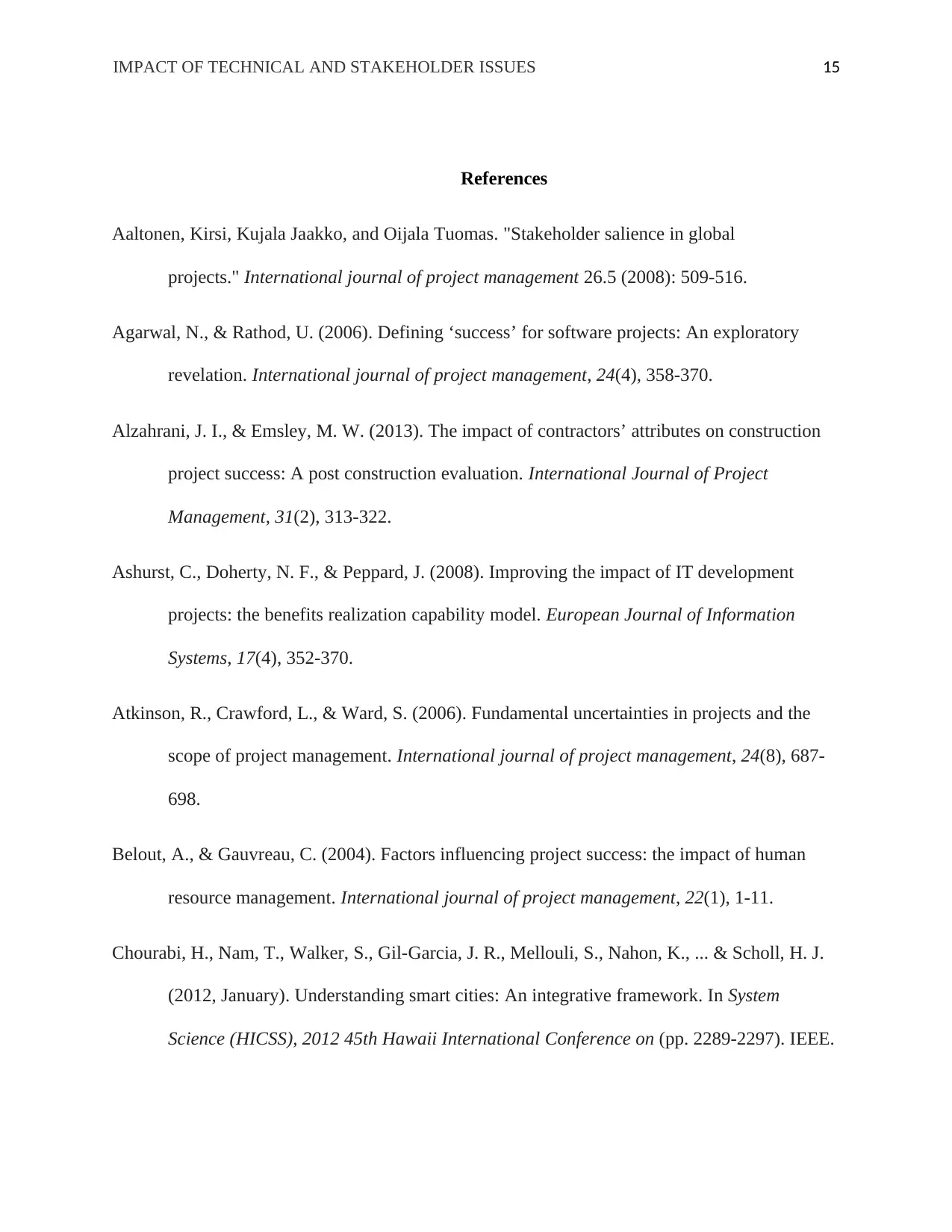
IMPACT OF TECHNICAL AND STAKEHOLDER ISSUES 15
References
Aaltonen, Kirsi, Kujala Jaakko, and Oijala Tuomas. "Stakeholder salience in global
projects." International journal of project management 26.5 (2008): 509-516.
Agarwal, N., & Rathod, U. (2006). Defining ‘success’ for software projects: An exploratory
revelation. International journal of project management, 24(4), 358-370.
Alzahrani, J. I., & Emsley, M. W. (2013). The impact of contractors’ attributes on construction
project success: A post construction evaluation. International Journal of Project
Management, 31(2), 313-322.
Ashurst, C., Doherty, N. F., & Peppard, J. (2008). Improving the impact of IT development
projects: the benefits realization capability model. European Journal of Information
Systems, 17(4), 352-370.
Atkinson, R., Crawford, L., & Ward, S. (2006). Fundamental uncertainties in projects and the
scope of project management. International journal of project management, 24(8), 687-
698.
Belout, A., & Gauvreau, C. (2004). Factors influencing project success: the impact of human
resource management. International journal of project management, 22(1), 1-11.
Chourabi, H., Nam, T., Walker, S., Gil-Garcia, J. R., Mellouli, S., Nahon, K., ... & Scholl, H. J.
(2012, January). Understanding smart cities: An integrative framework. In System
Science (HICSS), 2012 45th Hawaii International Conference on (pp. 2289-2297). IEEE.
References
Aaltonen, Kirsi, Kujala Jaakko, and Oijala Tuomas. "Stakeholder salience in global
projects." International journal of project management 26.5 (2008): 509-516.
Agarwal, N., & Rathod, U. (2006). Defining ‘success’ for software projects: An exploratory
revelation. International journal of project management, 24(4), 358-370.
Alzahrani, J. I., & Emsley, M. W. (2013). The impact of contractors’ attributes on construction
project success: A post construction evaluation. International Journal of Project
Management, 31(2), 313-322.
Ashurst, C., Doherty, N. F., & Peppard, J. (2008). Improving the impact of IT development
projects: the benefits realization capability model. European Journal of Information
Systems, 17(4), 352-370.
Atkinson, R., Crawford, L., & Ward, S. (2006). Fundamental uncertainties in projects and the
scope of project management. International journal of project management, 24(8), 687-
698.
Belout, A., & Gauvreau, C. (2004). Factors influencing project success: the impact of human
resource management. International journal of project management, 22(1), 1-11.
Chourabi, H., Nam, T., Walker, S., Gil-Garcia, J. R., Mellouli, S., Nahon, K., ... & Scholl, H. J.
(2012, January). Understanding smart cities: An integrative framework. In System
Science (HICSS), 2012 45th Hawaii International Conference on (pp. 2289-2297). IEEE.
You're viewing a preview
Unlock full access by subscribing today!
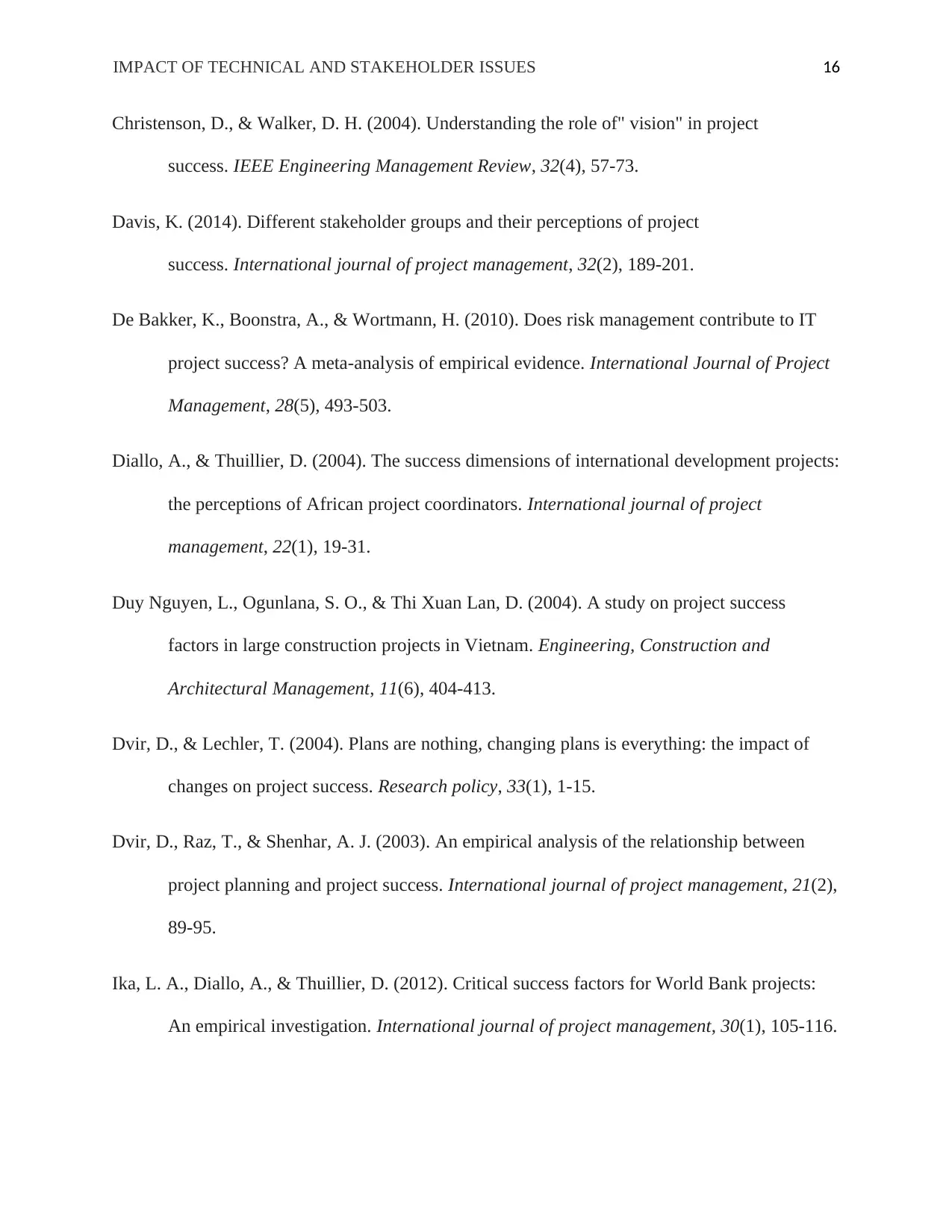
IMPACT OF TECHNICAL AND STAKEHOLDER ISSUES 16
Christenson, D., & Walker, D. H. (2004). Understanding the role of" vision" in project
success. IEEE Engineering Management Review, 32(4), 57-73.
Davis, K. (2014). Different stakeholder groups and their perceptions of project
success. International journal of project management, 32(2), 189-201.
De Bakker, K., Boonstra, A., & Wortmann, H. (2010). Does risk management contribute to IT
project success? A meta-analysis of empirical evidence. International Journal of Project
Management, 28(5), 493-503.
Diallo, A., & Thuillier, D. (2004). The success dimensions of international development projects:
the perceptions of African project coordinators. International journal of project
management, 22(1), 19-31.
Duy Nguyen, L., Ogunlana, S. O., & Thi Xuan Lan, D. (2004). A study on project success
factors in large construction projects in Vietnam. Engineering, Construction and
Architectural Management, 11(6), 404-413.
Dvir, D., & Lechler, T. (2004). Plans are nothing, changing plans is everything: the impact of
changes on project success. Research policy, 33(1), 1-15.
Dvir, D., Raz, T., & Shenhar, A. J. (2003). An empirical analysis of the relationship between
project planning and project success. International journal of project management, 21(2),
89-95.
Ika, L. A., Diallo, A., & Thuillier, D. (2012). Critical success factors for World Bank projects:
An empirical investigation. International journal of project management, 30(1), 105-116.
Christenson, D., & Walker, D. H. (2004). Understanding the role of" vision" in project
success. IEEE Engineering Management Review, 32(4), 57-73.
Davis, K. (2014). Different stakeholder groups and their perceptions of project
success. International journal of project management, 32(2), 189-201.
De Bakker, K., Boonstra, A., & Wortmann, H. (2010). Does risk management contribute to IT
project success? A meta-analysis of empirical evidence. International Journal of Project
Management, 28(5), 493-503.
Diallo, A., & Thuillier, D. (2004). The success dimensions of international development projects:
the perceptions of African project coordinators. International journal of project
management, 22(1), 19-31.
Duy Nguyen, L., Ogunlana, S. O., & Thi Xuan Lan, D. (2004). A study on project success
factors in large construction projects in Vietnam. Engineering, Construction and
Architectural Management, 11(6), 404-413.
Dvir, D., & Lechler, T. (2004). Plans are nothing, changing plans is everything: the impact of
changes on project success. Research policy, 33(1), 1-15.
Dvir, D., Raz, T., & Shenhar, A. J. (2003). An empirical analysis of the relationship between
project planning and project success. International journal of project management, 21(2),
89-95.
Ika, L. A., Diallo, A., & Thuillier, D. (2012). Critical success factors for World Bank projects:
An empirical investigation. International journal of project management, 30(1), 105-116.
Paraphrase This Document
Need a fresh take? Get an instant paraphrase of this document with our AI Paraphraser
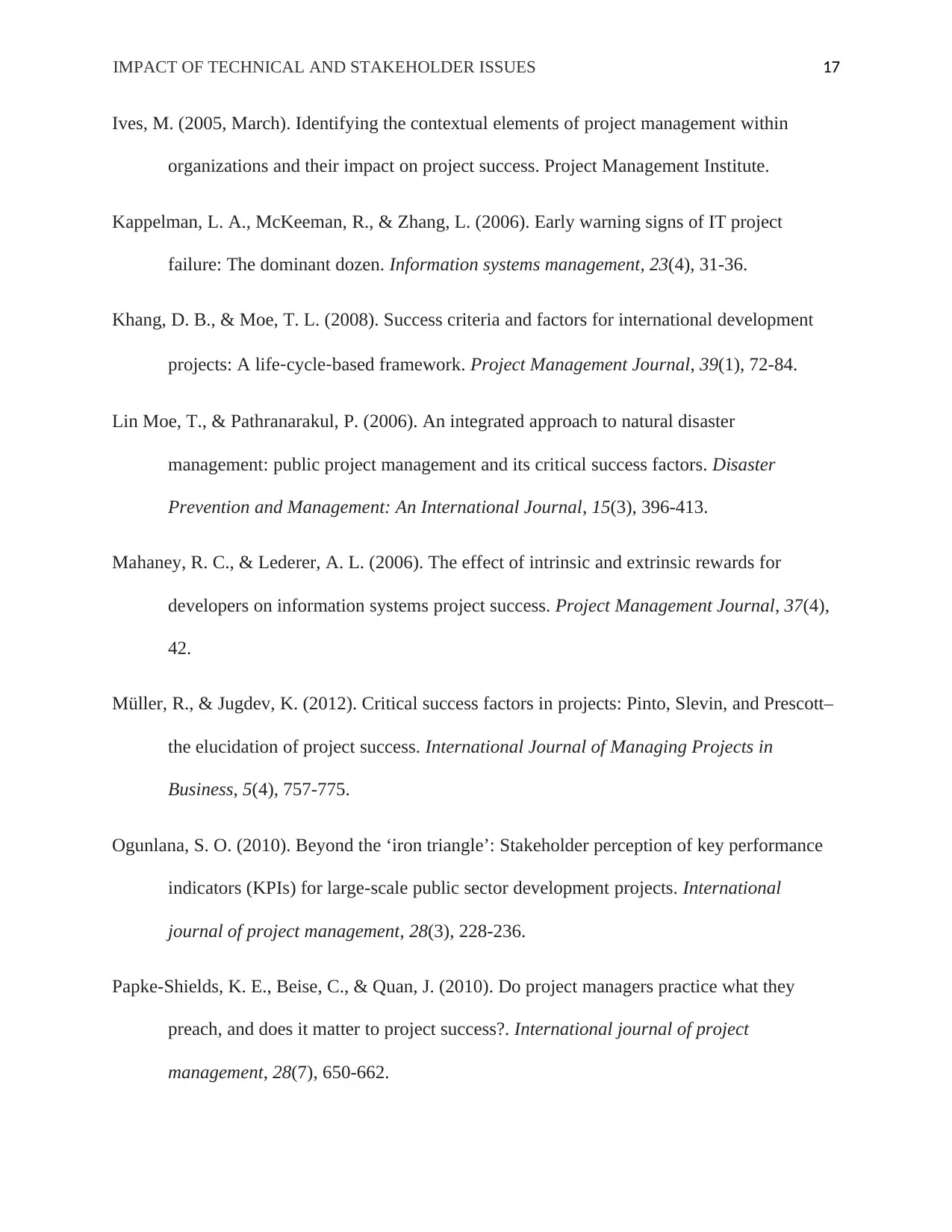
IMPACT OF TECHNICAL AND STAKEHOLDER ISSUES 17
Ives, M. (2005, March). Identifying the contextual elements of project management within
organizations and their impact on project success. Project Management Institute.
Kappelman, L. A., McKeeman, R., & Zhang, L. (2006). Early warning signs of IT project
failure: The dominant dozen. Information systems management, 23(4), 31-36.
Khang, D. B., & Moe, T. L. (2008). Success criteria and factors for international development
projects: A life‐cycle‐based framework. Project Management Journal, 39(1), 72-84.
Lin Moe, T., & Pathranarakul, P. (2006). An integrated approach to natural disaster
management: public project management and its critical success factors. Disaster
Prevention and Management: An International Journal, 15(3), 396-413.
Mahaney, R. C., & Lederer, A. L. (2006). The effect of intrinsic and extrinsic rewards for
developers on information systems project success. Project Management Journal, 37(4),
42.
Müller, R., & Jugdev, K. (2012). Critical success factors in projects: Pinto, Slevin, and Prescott–
the elucidation of project success. International Journal of Managing Projects in
Business, 5(4), 757-775.
Ogunlana, S. O. (2010). Beyond the ‘iron triangle’: Stakeholder perception of key performance
indicators (KPIs) for large-scale public sector development projects. International
journal of project management, 28(3), 228-236.
Papke-Shields, K. E., Beise, C., & Quan, J. (2010). Do project managers practice what they
preach, and does it matter to project success?. International journal of project
management, 28(7), 650-662.
Ives, M. (2005, March). Identifying the contextual elements of project management within
organizations and their impact on project success. Project Management Institute.
Kappelman, L. A., McKeeman, R., & Zhang, L. (2006). Early warning signs of IT project
failure: The dominant dozen. Information systems management, 23(4), 31-36.
Khang, D. B., & Moe, T. L. (2008). Success criteria and factors for international development
projects: A life‐cycle‐based framework. Project Management Journal, 39(1), 72-84.
Lin Moe, T., & Pathranarakul, P. (2006). An integrated approach to natural disaster
management: public project management and its critical success factors. Disaster
Prevention and Management: An International Journal, 15(3), 396-413.
Mahaney, R. C., & Lederer, A. L. (2006). The effect of intrinsic and extrinsic rewards for
developers on information systems project success. Project Management Journal, 37(4),
42.
Müller, R., & Jugdev, K. (2012). Critical success factors in projects: Pinto, Slevin, and Prescott–
the elucidation of project success. International Journal of Managing Projects in
Business, 5(4), 757-775.
Ogunlana, S. O. (2010). Beyond the ‘iron triangle’: Stakeholder perception of key performance
indicators (KPIs) for large-scale public sector development projects. International
journal of project management, 28(3), 228-236.
Papke-Shields, K. E., Beise, C., & Quan, J. (2010). Do project managers practice what they
preach, and does it matter to project success?. International journal of project
management, 28(7), 650-662.
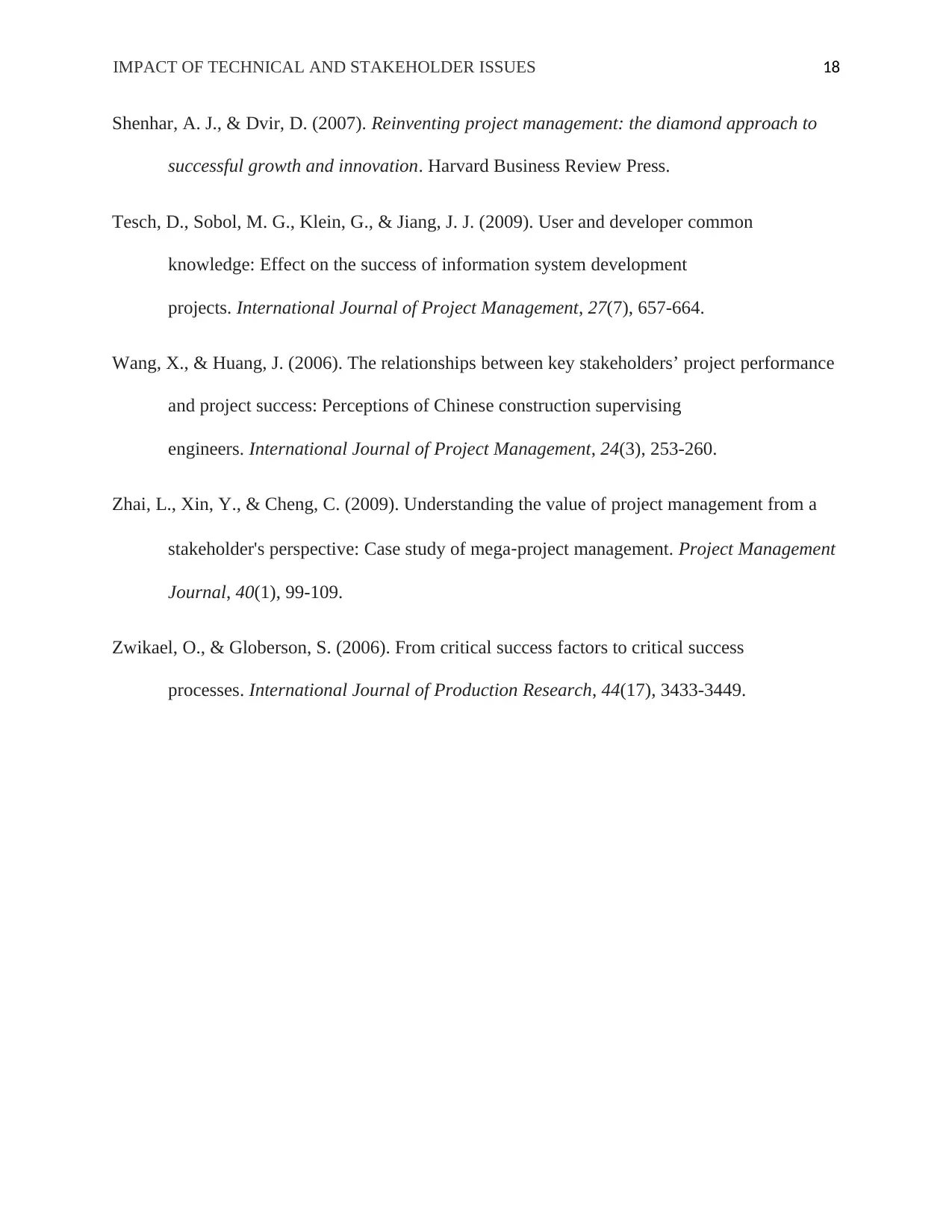
IMPACT OF TECHNICAL AND STAKEHOLDER ISSUES 18
Shenhar, A. J., & Dvir, D. (2007). Reinventing project management: the diamond approach to
successful growth and innovation. Harvard Business Review Press.
Tesch, D., Sobol, M. G., Klein, G., & Jiang, J. J. (2009). User and developer common
knowledge: Effect on the success of information system development
projects. International Journal of Project Management, 27(7), 657-664.
Wang, X., & Huang, J. (2006). The relationships between key stakeholders’ project performance
and project success: Perceptions of Chinese construction supervising
engineers. International Journal of Project Management, 24(3), 253-260.
Zhai, L., Xin, Y., & Cheng, C. (2009). Understanding the value of project management from a
stakeholder's perspective: Case study of mega‐project management. Project Management
Journal, 40(1), 99-109.
Zwikael, O., & Globerson, S. (2006). From critical success factors to critical success
processes. International Journal of Production Research, 44(17), 3433-3449.
Shenhar, A. J., & Dvir, D. (2007). Reinventing project management: the diamond approach to
successful growth and innovation. Harvard Business Review Press.
Tesch, D., Sobol, M. G., Klein, G., & Jiang, J. J. (2009). User and developer common
knowledge: Effect on the success of information system development
projects. International Journal of Project Management, 27(7), 657-664.
Wang, X., & Huang, J. (2006). The relationships between key stakeholders’ project performance
and project success: Perceptions of Chinese construction supervising
engineers. International Journal of Project Management, 24(3), 253-260.
Zhai, L., Xin, Y., & Cheng, C. (2009). Understanding the value of project management from a
stakeholder's perspective: Case study of mega‐project management. Project Management
Journal, 40(1), 99-109.
Zwikael, O., & Globerson, S. (2006). From critical success factors to critical success
processes. International Journal of Production Research, 44(17), 3433-3449.
You're viewing a preview
Unlock full access by subscribing today!
1 out of 18
Related Documents
Your All-in-One AI-Powered Toolkit for Academic Success.
+13062052269
info@desklib.com
Available 24*7 on WhatsApp / Email
![[object Object]](/_next/static/media/star-bottom.7253800d.svg)
Unlock your academic potential
© 2024 | Zucol Services PVT LTD | All rights reserved.





